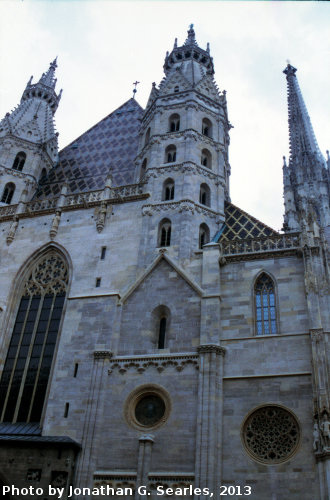(St. Stephen's Cathedral) Wien, Picture 21, Edited…
Rochusgasse U-Bahn Station, Wien (Vienna), Austria…
Stephansplatz U-Bahn Station, Wien (Vienna), Austr…
Virgilikapelle, Wien (Vienna), Austria, 2013
Virgilikapelle, Picture 2, Wien (Vienna), Austria,…
Virgilikapelle, Picture 3, Wien (Vienna), Austria,…
Wien (Vienna), Picture 22, Edited Version, Austria…
Wien (Vienna), Picture 26, Edited Version, Austria…
Wien (Vienna), Picture 29, Edited Version, Austria…
Renault Twizy, Wien (Vienna), Austria, 2013
Renault Twizy, Picture 2, Wien (Vienna), Austria,…
Vivaldi Plaque, Wien (Vienna), Austria, 2013
Sacher Hotel, Wien (Vienna), Austria, 2013
Sacher Hotel, Picture 2, Wien (Vienna), Austria, 2…
Sacher Hotel, Picture 3, Wien (Vienna), Austria, 2…
Schwartenberg Brewpub, Wien (Vienna), Austria, 201…
Schwartzenberg Brewpub, Picture 2, Wien (Vienna),…
Schwartzenberg Brewpub, Picture 3, Wien (Vienna),…
Schwartzenberg Brewpub, Picture 4, Wien (Vienna),…
Wien (Vienna), Picture 31, Edited Version, Austria…
Wien (Vienna), Picture 32, Edited Version, Austria…
750 Jahre Wiener Hafner 1234-1984 Mosaic, Wien (Vi…
Royal Enfield Motorbike, Wien (Vienna), Austria, 2…
Wien, Picture 17, Edited Version, Austria, 2013
Wien (Vienna), Picture 16, Edited Version, Austria…
Wien (Vienna), Picture 12, Edited Crop, Austria, 2…
Victor-Braun-Platz Sign, Wien (Vienna), Austria, 2…
Waizenhaus Kirche, Wien (Vienna), Austria, 2013
Tram #1480, Edited Crop, Wien (Vienna), Austria, 2…
Tram #4096, Edited Version, Wien (Vienna), Austria…
Palais Schwartzenberg, Picture 2, Edited Version,…
Palais Schwarztenberg, Edited Version, Wien (Vienn…
Palais Schwartzenberg Plaque, Wien (Vienna), Austr…
Soviet World War II Memorial, Picture 10, Wien (Vi…
Soviet World War II Memorial, Picture 6, Edited Ve…
Soviet World War II Memorial, Picture 4, Edited Ve…
Soviet World War II Memorial, Edited Version, Wien…
(French Embassy) Wien (Vienna), Picture 8, Edited…
Wien (Vienna), Picture 5, Edited Version, Austria,…
Osterreichische Werkstatten, Wien (Vienna), 2013
Dual Power Buses, Wien (Vienna), 2013
Stadt Boden Breakfast, Wien (Vienna), 2013
Daniel Moser Coffee, Picture 2, Wien (Vienna), 201…
Wien Hauptbahhof U-Bahn, Picture 2, Wien (Vienna),…
Wien Hauptbahnhof U-Bahn, Wien (Vienna), Austria,…
See also...
Keywords
Authorizations, license
-
Visible by: Everyone -
All rights reserved
-
185 visits
(St. Stephen's Cathedral) Wien, Picture 20, Edited Version, Austria, 2013


When I originally prepared the photos from this roll, I had forgotten what this was, so I just made the title another generic "Wien" photo. This is St. Stephen's Cathedral, or the Stephensdom, built and rebuilt in various forms between 1263 and 1511, although the two towers date to about 30 years earlier (the exact date isn't clear), as they had been from the second church on this site, as the Stephensdom is the third (or possibly fourth). The first known church, built between 1137 and 1160. One theory that some historians and archeologists have, though, is that there was an earlier church (or possibly pagan temple) as far back as the 4th Century, as in 2000 a cemetary carbon-dated to that period was found during an archeological dig. Normally, of course, cemetaries in Christian countries were adjacent to churches. However, the 4th Century was not well recorded enough to know for sure, as it was at the beginning of the "dark ages" of European history. The during later periods, there were catacombs, which were used until 1783, and these still exist. An estimated 11,000 bodies are kept there. Another cemetary (not the 4th Century one) also existed next to the cathedral until 1781, with its own separate chapel (more on this in a later post). There are also crypts that are still in use, but these are used for church officials, for example the Bishop's Crypt, which was used as recently as 2004 to inter Cardinal Franz Konig. On the more positive side, the Stephensdom first had an organ in 1334, which must have been a very impressive piece of technology at the time. In 1945, the Cathedral was burned, although not directly from battle (although the Nazi commandant of the city had unsuccessfully ordered the cathedral destroyed). Although the city was invaded and occupied by the Soviet army in the last two months of World War II, looters set fire to nearby shops, which spread to the cathedral. Fire and bombing had been anticipated, so protective shells made of bricks had been constructed around parts of the interior. However, these were not enough to save everything, and this included the organ that existed at the time (it isn't clear if it was the 1334 original). An electric organ was fitted in 1960, roughly eight years after the cathedral reopened, and this was replaced by a more traditional mechanical one in 1991.
- Keyboard shortcuts:
Jump to top
RSS feed- Latest comments - Subscribe to the comment feeds of this photo
- ipernity © 2007-2025
- Help & Contact
|
Club news
|
About ipernity
|
History |
ipernity Club & Prices |
Guide of good conduct
Donate | Group guidelines | Privacy policy | Terms of use | Statutes | In memoria -
Facebook
Twitter

Sign-in to write a comment.